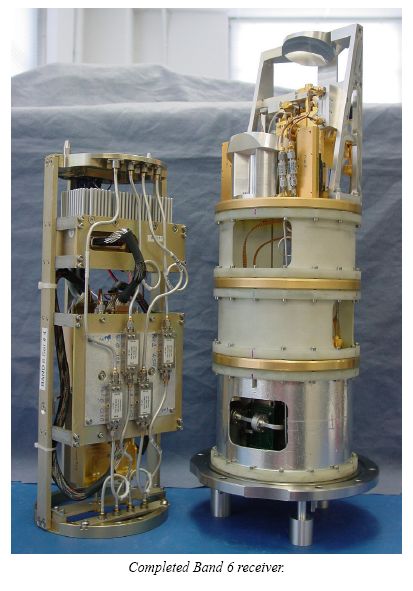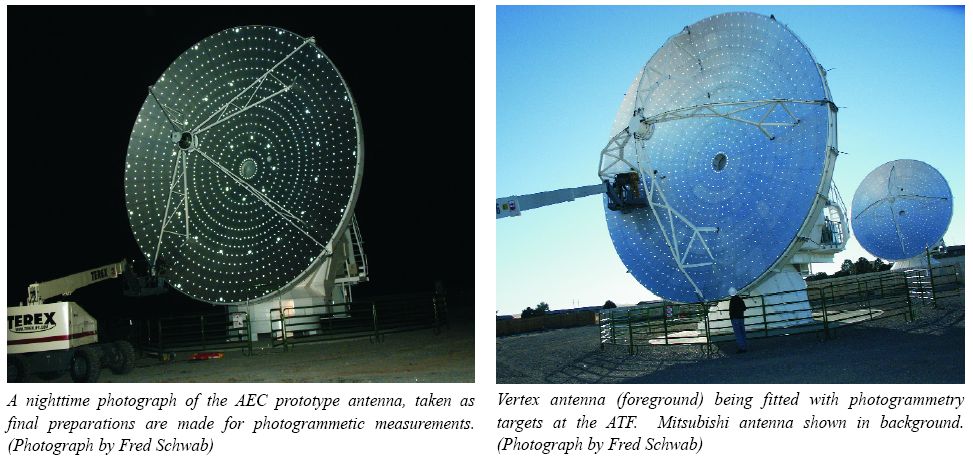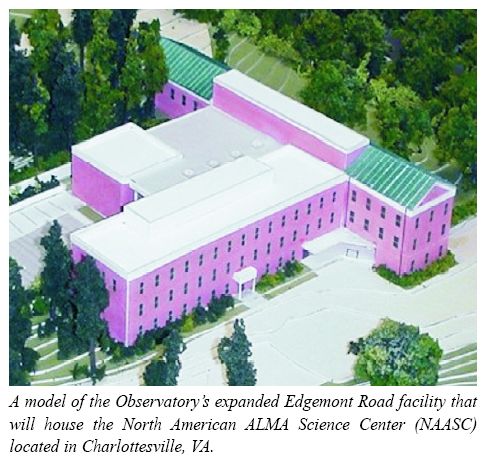ALMA NRAO News April 2005
ALMA News from the April 2005 Issue of the NRAO Newsletter
ATACAMA LARGE MILLIMETER ARRAY (ALMA)
ALMA News
ALMA construction continues at sites worldwide. President Bush signed the FY2005 budget, which allocates $49.30M to ALMA construction, the fourth year of full ALMA construction funding and, including the design and development phase, the seventh year of ALMA funding. The FY06 request seeks full funding for the fifth year of construction, at $49.24M. At the end of January, the ALMA-Japan partner announced signature of a contract to build three 12m antennas to be incorporated into the ALMA Compact Array. Contracts for the balance of the antennas are imminent.
An ALMA Town Meeting was held on January 11, 2005 (Tuesday) during the 205th AAS Meeting in San Diego, CA. The meeting was an outstanding success, with discussion continuing afterward such that the room had to be cleared so that the next session could begin. At the meeting, an ALMA booth was staffed by ALMA personnel to answer questions. Booths are planned for the upcoming AAS meeting in Minneapolis May 29June 2 and also at the CASCA meeting in Montreal May 15-17. ALMA will also be discussed at the 2005 IEEE International Conference on Acoustics, Speech, and Signal Processing, held March 18-23, 2005 in Philadelphia, as one element in a special session entitled “Towards A New Generation of Radio Astronomical Instruments: Signal Processing for Large Distributed Arrays”.
Phil Myers left the ALMA Science Advisory Committee (ASAC). Andrew Blain of Caltech was nominated by NSF and confirmed by the ALMA Board at its January 27, 2005 telecon. Jean Turner is currently Chairperson of the ASAC. Jim Crocker of Lockheed Martin has replaced Dominick Tenerelli as a North American ALMA Management Advisory Committee member.
In electronics labs around the world, engineers are assembling ALMA components into functioning units and measuring performance against specifications. In
 Tucson, the Local Oscillator (LO) system is undergoing phase drift
measurements; the prototype of the LO Photonics Line Length Corrector
and Second Laser Synthesizer are under test. At the Array Operations
Center (AOC) in Socorro, tests focus on elements of the backend,
including data transmission system, prototype correlator, samplers,
and digitizers. ALMA Computing in North America is also carried out in
Socorro. At the NRAO Technology Center (NTC) in Charlottesville,
assembly of the first quadrant of the ALMA correlator is nearing
completion. The multipliers (tunerless!) have been assembled and
delivered to receiver cartridge builders around the world. In the NTC,
the first Band 6 (1.3mm) cartridge has been assembled and tested;
others are in an advanced state of assembly. Soon, these elements
will be brought together at the Antenna Test Facility and assembled
into a one-baseline forerunner of ALMA for prototype system
integration and astronomical testing.
Tucson, the Local Oscillator (LO) system is undergoing phase drift
measurements; the prototype of the LO Photonics Line Length Corrector
and Second Laser Synthesizer are under test. At the Array Operations
Center (AOC) in Socorro, tests focus on elements of the backend,
including data transmission system, prototype correlator, samplers,
and digitizers. ALMA Computing in North America is also carried out in
Socorro. At the NRAO Technology Center (NTC) in Charlottesville,
assembly of the first quadrant of the ALMA correlator is nearing
completion. The multipliers (tunerless!) have been assembled and
delivered to receiver cartridge builders around the world. In the NTC,
the first Band 6 (1.3mm) cartridge has been assembled and tested;
others are in an advanced state of assembly. Soon, these elements
will be brought together at the Antenna Test Facility and assembled
into a one-baseline forerunner of ALMA for prototype system
integration and astronomical testing.
As ALMA construction has led to realization of its various elements, from prototype antennas through samplers and correlators to front ends, the project has evolved from the baseline set down at the outset of construction. Over the winter, the project has engaged in using the information gleaned from construction of the elements of ALMA to rebaseline the project as it is currently envisioned. This process has been informed by the realization last fall of an integrated project schedule, which defines critical paths through the many parts of ALMA. The rebaselined project will be discussed with the ALMA Board, itself consulting with its scientific and management advisory committees (ASAC and AMAC respectively) before being finalized.
Any task of this magnitude requires a fully-staffed Joint ALMA Office. Only one remaining JAO position, that of the ALMA Project Scientist, remains to be filled. Advertisements have been placed with a goal of speedily identifying and hiring the most qualified candidate.
At the ALMA Camp adjacent to the site of the Operations Support Facility (OSF) near San Pedro de Atacama, the focus is on support of the imminent effort to construct the ALMA facilities at both the OSF and at the Array Operations Site on the Chajnantor plateau. To this end, the road between the two sites is being finished, and the ALMA Camp and the Construction Camp are being enlarged.
H. A. Wootten
ALMA Test Facility
Since the turn of the year, activity has ramped up at the ALMA Test Facility (ATF) located at the Very Large Array site. All bids received for production antennas were based on the prototype antennas located at the ATF. The Antenna Evaluation Group (AEG) performed a number of tests on these antennas aimed at demonstrating their performance relative to the technical specifications for the antennas. Owing to a number of factors—antenna delivery schedule, weather at the VLA site, and poor optical seeing at the ATF among them—the data sets earlier produced by the AEG left interpretation of the performance relative to specifications open to question.

Since the performance of prototypes relative to the technical specifications was a key issue in bid evaluation, a Joint Antenna Technical Group consisting of experts in antenna design and testing was assembled at the ATF to conduct a new series of tests aimed at resolving issues remaining from the report of the Antenna Evaluation Group. These tests have been run during January through the beginning of March 2005. Tests included holography using a transmitter on a nearby tower, photogrammetry of the antennas over a range of elevations, out-of-focus beam maps and out-of-focus holography of astronomical sources, pointing with the optical pointing telescope, and radiometry of astronomical sources. While still under scrutiny, it appears that these tests have resolved most remaining questions. The testing concludes with a period of ten-second fast-switching cycles on the antennas. This involves continuously fast-switching the antennas for about 100,000 cycles: 24 hours per day for about 14 days or 42 eight-hour shifts.
At the conclusion of this round of tests, the project will contract for the production antennas armed with a more complete understanding of the performance of the prototype antennas.
Independent of the testing of the two antennas supplied by the ALMA bilateral partners, a Japanese prototype has also been tested at the ATF. Based on these tests and an independent bidding process, Japan selected Mitsubishi to produce three 12m antennas which will be included in the Atacama Compact Array and signed a three-year contract with them on January 31, 2005.
H. A. Wootten
North American ALMA Science Center
The North American ALMA Science Center (NAASC) will be the main interface between the North American user community and the Joint ALMA observatory. In addition to hosting a complete copy of the ALMA archive, the NAASC will provide North American astronomers support with proposal submission, observing scheduling, data reduction, and outreach activities such as workshops and Summer Schools. More information can be found at the NAASC website at: http://www.cv.nrao.edu/naasc/.

The NAASC is poised to occupy its new offices in the addition to the NRAO Edgemont Road Building, located on the grounds of the University of Virginia in Charlottesville, Virginia. The move is expected to be complete by early April. Initially, the Science Center will be located in a suite of offices on the third floor, above the office of the North American ALMA (Construction) Project. Others moving into the new space include NRAO Administration and Human Resources. Renovation of the Library, Auditorium, and common spaces will provide excellent facilities for visitors to the NAASC and for ALMA workshops.
The ALMA North American Science Advisory Committee (ANASAC) provides scientific advice on the operation of the NAASC to NRAO as representatives of the wider North American astronomical community. The ANASAC welcomed new members for a three-year term at its meeting on February 18, 2005: Andrew Baker (Jansky Fellow, U. Maryland), John Bally (U. Colorado), Crystal Brogan (JCMT Fellow, U. Hawaii), Paul Ho (CfA, Harvard), Jonathan Williams (U. Hawaii), and Mel Wright (UC - Berkeley). Members continuing for two years are: Andrew Blain (Caltech), Xiaohui Fan (U. Arizona), Doug Johnstone (HIA/DAO, Victoria), Lee Mundy (U. Maryland), Jean Turner (UCLA), and Christine Wilson (McMaster U.); and for one year: Chris Carilli (NRAO), Richard Crutcher (U. Illinois), Jason Glenn (U. Colorado), Mark Gurwell (CfA, Harvard),Joan Najita (NOAO), and Min Yun (U. Mass.). Special thanks go to members completing their service on the ANASAC: Phil Myers (CfA, Harvard), Dave Hollenbach (NASA - Ames), Dan Jaffe (U. Texas - Austin), Luis Rodriguez (UNAM), Dave Sanders (U. Hawaii), and Dick Plambeck (UC - Berkeley).
P. Vanden Bout




Connect with NRAO